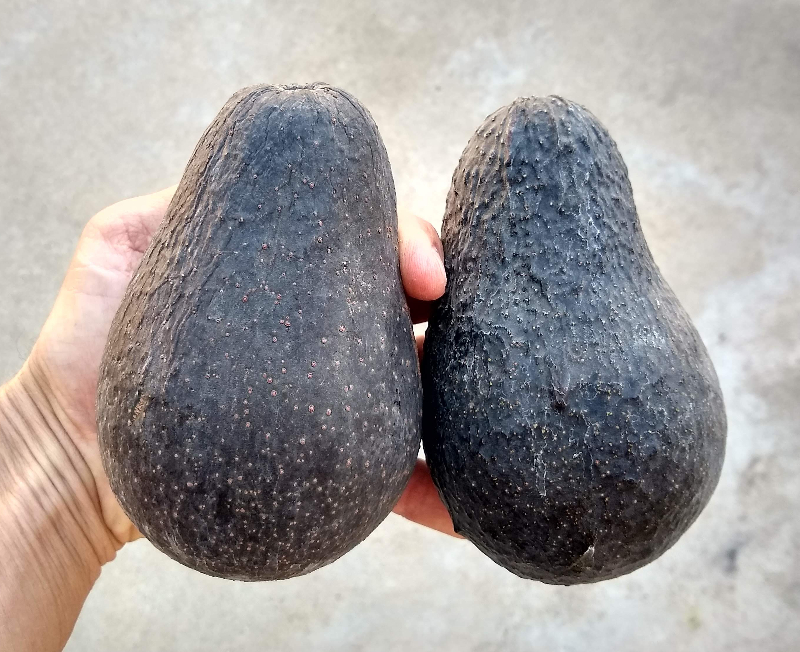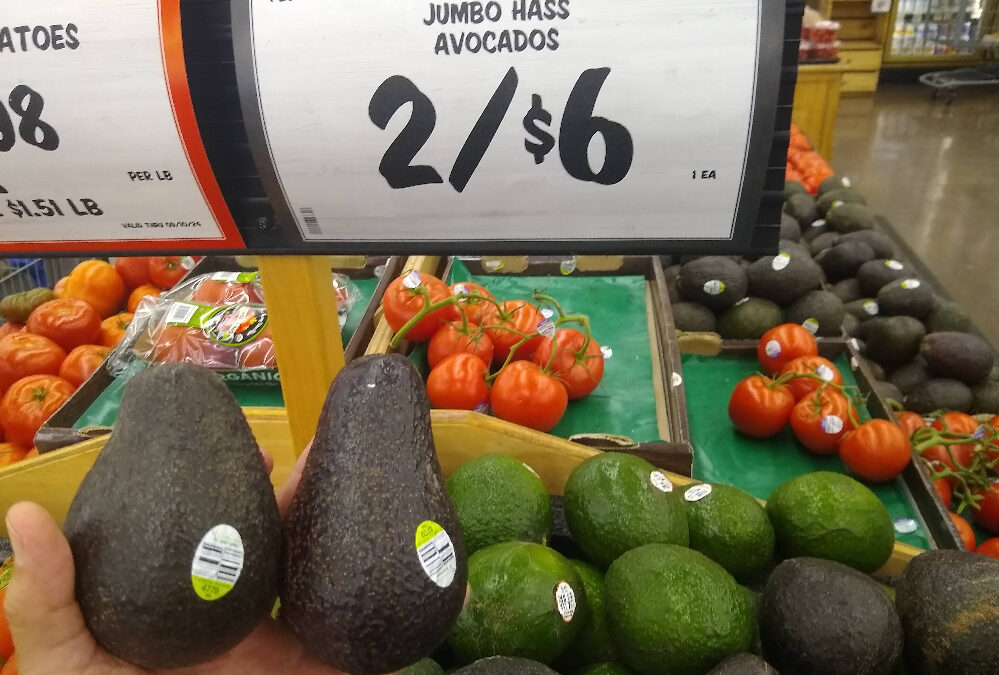I found this display in a Sprouts market in San Diego County last week. Such displays selling “Jumbo Hass” avocados can be found in many grocery stores in California during August and September.
What’s a “Jumbo Hass?” Is it a really big fruit of the Hass variety, or is it a distinct variety? Or something else?
The stickers on the fruit in this display all have the same PLU (price look-up) code, which is 4770. That code is to be used for Hass avocados of a specific large size, called 36, which weigh between 10.5 and 12.5 ounces. (See here and here.)
So they are really big Hass avocados, right?
But do you notice that some of the avocados are black while others are green? Reading the stickers, you’ll also find that the black avocados are from California while the green avocados are from Mexico. What’s that all about? Are they actually two different varieties being sold under the same PLU and in the same bin?
The answers
In the display above, the green avocados are Hass avocados from Mexico whereas the black avocados are Lamb avocados from California. They are two completely distinct varieties that have been mixed together and are being sold under the label “Jumbo Hass.”
Why are the Hass from Mexico green? Because at this time of year, the crop is barely mature. The fruit will taste a bit watery and bland.
Why are the Lamb from California black? Because at this time of year, Lamb avocados in California are perfectly mature and they will taste as good as they get.
How is Lamb different from Hass? Completely different. It’s like asking how a Honeycrisp apple is different from a Golden Delicious apple. Or it’s like asking how you are different from your great grandmother.
Lamb came from a seed of the Gwen variety, Gwen came from a Thille seed, and Thille came from a Hass seed. So you could say that Lamb is a great granddaughter of Hass. Yet, in no way could you say that Lamb is Hass.
And Lamb shouldn’t be sold in grocery stores as if it is Hass.
Lamb is a bigger avocado, has a different harvest season, has thicker, stiffer skin, greener flesh, and a smaller seed compared to Hass.
Lamb should be treated by marketers and retailers as the distinct variety that it is, and thereby treat avocado consumers with the respect that they deserve.
It’s easy to let a Lamb avocado rot on the counter because, due to its thicker, stiffer skin, it doesn’t feel ripe in the same way that a Hass does. Avocado eaters should be clued into this by being informed that they’re eating a different variety.

See my profile of the Lamb avocado variety here.




I have bought a few of these from sprouts. My guess is they are lamb Hass. I have also seen what appears to be gems ( both from USA)
I don’t know the answer but I won’t buy Mexican avocados after being burned with grey flesh. I never complained or went back to the grocery store and I assume others didn’t either. Only lack of sales will change the produce manager’s mind.
My guess is the large ones are Lamb/Hass. I have a young Lamb/Hass and had a couple ‘cados from it last year. It has maybe a dozen on it now. It lost some during the recent 112 degree heat wave. I found them delicious.
I saw these at sprouts too and initially thought they could be reeds but then remembered that I had bought reeds from sprouts in years past that were correctly labeled. I ended up not buying them, so I’m not sure
Reeds are also a little less necky/more round and tend to be more of a November harvest. I’d guess lamb. I guess….
True, I re-read the post and realized the ones I had seen at my store looked more like the green ones on the shelf in his photo, which aren’t as necky.
I’m going to have a guess and say the green ones from Mexico are Reeds and the black ones from California are Lambs
I dont know what they are, but I’m excited to find out. I will be making sure I get a tree!
I assume that Cal and Mexican Jumbo Hass are the same variety but shipped green from Mexico to avoid bruising.
I bought some”large Hass” avocados from Sprouts a couple of years ago. The sign on the table said “large Hass”. The sticker on the avocado said “L Hass”. They sure look a lot like the fruit on my Lamb Hass tree. I am guessing that the produce people at Sprouts just guessed that what the “L” meant was “large” and never gave it another thought.
Most on my Hass tree are 6 to 8oz, but I actually had a few large size, almost 10 oz, so it could be the large ones ( sort of like with chiken eggs? ), although I think mistaking L for large sounds very likely, I agree with Ken on this one…
Been spoiled by the avocados you source! I did buy Dickinson Farm Reed avocados and they ripened very quickly – almost too quickly.
I retired from the grocery business. We had to know our produce codes, and we certainly do not need more codes and the different varieties to remember.
Bought a Large avocado at El Super in National City labled “Florida king”. Planning on eating it in a couple of days…
Hi Greg: I bought 6 from Ralphs, maybe just Large as they all weigh approx 10.5~11.0 oz. They were blackish. I’m guessing lamb hass? What say you?
Years ago when I needed to buy avocados I purchased mainly from Costco. Their main avocado suppliers were Mexico, Chili, USA, and Peru. The sign always stated, “Hass”. Most of the time the fruit was something similar, but something else. As I recall, the avocados from Peru looked exactly like the Hass I grow. The avocados from Chili were definitely some variety other than Hass with a brownish tint and a different shape, but they darkened when ripe. Mexico is by far the largest producer of avocados world wide. The variety I see from Mexico most often is similar to Hass, but to anyone who grows Hass they are clearly not Hass. Usually, the avocados from the USA are genuine Hass. From watching Greg’s videos, I would guess that the large Hass is really a Lamb Hass.
If I buy avocados at the grocery, I always choose the greenest ones. They haven’t been bruised by people testing how soft ripe ones are. Last week I waited while the lady before me was like a machine going from one avocado to the next, squeezing each one with her fingertips. I ripen them in stages, keeping some in the fridge a couple days, while one or two are on the sinkboard, ripening.
For the first time this year I noticed at Ralphs jumbo/giant Hass avocados from Peru. They were truly the biggest avocado I have ever seen is California. Wondered if it was really a Hass. Apparently Peru is a big Hass avocado shipper to the USA March through September but with the size they were I am skeptical. On another note the bigest avocado I have ever seen was in Florida didn’t care for it’s texture or taste.